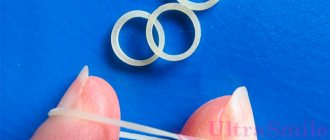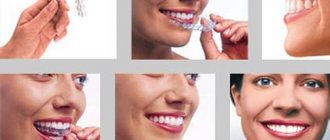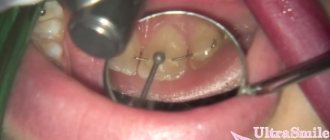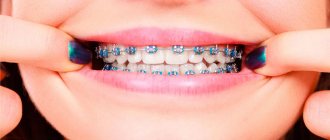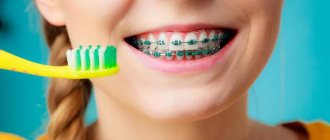Why do you need a dental guard after braces?
Braces correct the bite. This may take several months or even years. When the orthodontic appliance is finally removed, the patient experiences relief. But not everyone knows that after removing braces, teeth can return to their previous incorrect position. This is due to the structural features of the jaw and the physiology of the body, for which it is natural to resist outside interference.
In this article
- Why do you need a dental guard after braces?
- Types of removable mouthguards
- Advantages and disadvantages of removable aligners
- How is an orthodontic mouth guard installed?
- How long do you wear mouthguards after braces?
- How to care for aligners after braces?
- How to wear mouth guards after braces without damaging them?
- Conclusion
In order to prevent repeated curvature of teeth and to maintain the effect of bite correction achieved during orthodontic treatment, the orthodontist prescribes the patient to wear retainers. These are special structures that are worn during the retention period - a time when there is a risk of the tooth returning to its usual position. Retainers hold the teeth in the desired position and allow the ligaments to “get used” to the new bite.
Retainers are removable and non-removable. The latter are wires fixed on the inside of the teeth. A more convenient and popular option is a removable orthodontic mouthguard - after braces, it is worn only at night.
If there is strong bite resistance, the orthodontist may recommend wearing both removable mouth guards after braces and permanent retainers at the same time. In this case, the wire is worn constantly, and the mouth guard is worn only for a certain time at night or during the day.
Treatment of children using FlexiLigner aligners at the “Smile” dentistry
Dentists at the branches of our center use only reliable and proven technologies and devices to treat children. FlexiLigner aligners are one of them. The cost of therapy is from 350 thousand rubles. Treatment with KidsLight aligners costs from 90 thousand. This amount includes the manufacture of mouth guards, monthly visits to the doctor and retention devices.
The dental network offers affordable prices for orthodontic services, payment in installments during the course of correction, and a family discount when servicing several family members.
Our specialists regularly improve their professional status by studying in leading clinics in Russia and Europe. This allows us to offer world-class dental services to our patients.
The clinic has two branches in different areas of Moscow. You can choose the one that is more convenient for visiting:
- branch near the Alekseevskaya metro station (VDNKh area and Mira Avenue) at the address: st. 3rd Mytishchinskaya 3, building 2;
- Shelepikha metro station, address: Shelepikhinskaya embankment, 34, building 1.
It is within your power to make your child’s smile cheerful and beautiful, and to eliminate in advance the problems that he may encounter in the future. Come to our orthodontic centers, we can help you!
Types of removable mouthguards
Dental mouthguards differ in material, duration of wear, and production technology:
- Standard models are made according to one sample and do not take into account the specifics of an individual bite. Therefore, they are rarely used after braces. These types of trays are often used for teeth whitening.
- Thermally modeled retainers. Their peculiarity is that they take the unique shape of teeth after heating. Such a mouth guard is first placed in hot water and only then put on the jaw.
- Individual models are the most accurate and convenient. They are made according to the individual anatomical parameters of a particular patient based on a cast of the jaw.
According to the period of wearing, mouthguards are available at night and around the clock. The first ones are worn exclusively at night and are used in “mild” cases of bite correction. They are worn around the clock, removed only during meals and before oral hygiene. These models are suitable for correcting severe malocclusions.
According to the material, mouthguards can be made of silicone and bioplastic. Both options are distinguished by good hypoallergenic properties, transparency and non-invasiveness.
Features of use
Fixed retainers
Why wearing mouth guards is convenient:
- they are completely transparent and therefore almost invisible;
- do not cause significant speech defects;
- the patient quickly adapts and ceases to feel the presence of the device;
- the materials from which the structures are made do not injure the oral cavity and do not cause discomfort.
Possible problems:
- may cause mild discomfort;
- defects in the pronunciation of hissing sounds;
- difficulty putting on mouth guards, feeling of squeezing, pain;
Minor speech defects and discomfort occur only during the first time after starting to wear them and quickly disappear. Some patients find it difficult to wear aligners for long periods of time and sometimes need to remove them to rest. This is undesirable, but not prohibited.
It is important not to stop using aligners for a long time, since after 1-2 days the dentition will begin to return to its previous position. It is because of this that mouth guards can be difficult to fit on teeth and cause discomfort.
Advantages and disadvantages of removable aligners
Caps have many advantages:
- unlike fixed structures, they can be worn for a limited time;
- using mouthguards after braces is more comfortable, since the jaw “rests” from metal structures;
- Oral care is easier if the retainer can be removed.
The main disadvantage of aligners is that they are a noticeable design that affects appearance, so not everyone is ready to wear such retainers during the day. In addition, the design can cause increased salivation.
What is it used for?
Indications:
- crowding of teeth, which literally “crawl” onto each other and/or grow outside the dentition;
- large gaps between teeth – diastemas and trema;
- deep bite;
- gum disease;
- increased tooth wear;
- dysfunction and pain in the temporomandibular joints (TMJ);
- dysfunction of the musculo-ligamentous apparatus of the face;
- bruxism;
- preparatory stage before implantation;
- improper functioning of the chewing apparatus.
How is an orthodontic mouth guard installed?
The removable retainer is placed by the orthodontist for the first time; in the future, this can be done by the patient himself. Before the first installation, the doctor prepares the oral cavity for the installation of an orthodontic structure. Checks that the braces system does not damage tooth enamel, evaluates the presence of carious lesions, and covers the teeth with a special protective layer.
A custom-made or thermally modeled mouth guard is placed on the patient's teeth and shown how to remove and put it on independently.
Popular questions
Can a mouthguard be used instead of braces?
Mouthguards are used to correct malocclusions, but they are not suitable for all clinical cases. Serious anomalies cannot be corrected with their help: this requires braces or a combined approach, in which plates are used only at the final stage of treatment.
The mouth guard is cracked, what should I use to seal it?
You should not try to repair or seal a cracked or chipped mouth guard yourself: a broken device can damage your teeth. If you find mechanical damage to the mouthguard, you must stop wearing it and consult your doctor.
How long do you wear mouthguards after braces?
The most common question that patients ask their orthodontist is how long to wear mouth guards after removing braces. For each person, the wearing period is individual and determined by the doctor. For some, a year is enough to fix the bite; for others, it takes more than two years. If you want to roughly calculate how long you need to wear mouthguards after braces, you can use this conditional formula.
Take as a basis the time during which you wore the braces system and double it. This will be the approximate period of wearing the mouthguard. Many people wear it for two to four years. But there are also people whose muscle memory “refuses to remember” the new position of the jaw; the process of fixing the bite is very slow. In this case, you may need to wear a mouth guard for a longer period, sometimes for life.
Contraindications
Orthopedic mouth guards are useless for skeletal defects of the jaw bones and the presence of impacted teeth. They are not given to patients with TMJ pathologies, destructive damage to alveolar tissue and severe mental disorders.
Important!
Absolute contraindications include malignant tumors in the oral cavity, tuberculosis, cardiovascular pathologies in the stage of decompensation, autoimmune disorders and diseases in which bone density decreases.
Dental mouthguards are not used for severe diabetes mellitus, serious dysfunction of the thyroid gland, pituitary gland and adrenal glands. They are also contraindicated in cases of diagnosed lymphogranulomatosis, thalassemia, leukemia, hemolytic anemia and HIV.
How to care for aligners after braces?
Oral care when wearing orthodontic appliances should be as thorough as possible to avoid caries and other dental damage. Therefore, when installing retainers, the orthodontist must tell the patient how to properly care for the aligners. Below are basic rules for safe cleaning of orthodontic trays and oral care.
The aligners must be removed twice a day during morning and evening brushing. After removing the structure, you must thoroughly brush your teeth with a brush and paste, clean the interdental spaces with floss, floss or irrigator, and remove plaque from the gums, tongue, and inner surface of the cheeks.
The mouthguard itself is also carefully cleaned with a brush and paste, removing plaque and dirt from it. Once every seven days the structure is treated with a special disinfectant. It is also recommended to use mouthwash more often when wearing removable retainers.
Good to know
Those who are just starting to train and are faced with the procedure for preparing a mouth guard for the first time should know a few important points.
- If the burl is cooked incorrectly, do not throw it away - the cooking procedure can be repeated.
- It is not advisable to purchase cheap mouth guards, as this can have a negative impact on your oral health.
- A properly prepared mouth guard should fit tightly. If it sits poorly, it means mistakes were made during the cooking process.
- It is recommended to change the mouthguard every season, since this means of protection tends to wear out over time, which leads to the loss of its protective functions.
- There is no need to try to drown it when placing it in a bowl of hot water - it should just float there.
- After each workout, rinse the mouthguard under running cold water, after brushing with a brush and toothpaste.
- A well-ventilated special container is required to store the mouth guard.
- Do not leave it in the sun - direct exposure to sunlight can lead to deformation.
- If the mouthguard is overcooked, then nothing can be done with it.
Boxing is a rather dangerous sport, as injuries are inevitable during training and competition. But an athlete should think first not about his career, but about his health. A correctly selected and properly prepared mouthguard will preserve the integrity of the teeth, tongue and soft tissues of the face.
How to wear mouth guards after braces without damaging them?
Mouthguards are made of plastic material, so they can be easily damaged if handled carelessly. In this case, the device will no longer perform its main task - to hold the teeth in the correct position. If it breaks, it cannot be repaired; a new one will have to be made. Therefore, it is important to follow the rules of safe operation.
How to wear a mouthguard correctly:
- To avoid damage, it must be removed before each meal.
- Plastic aligners do not withstand high temperatures well, so you should not drink hot tea, coffee or other drinks with an orthodontic structure in your mouth.
- Between uses, the mouthguards are worn like other personal care products - in special lockable containers. This protects the device from contamination and damage.
- You cannot smoke with a mouth guard in your mouth, because tobacco smoke and tar change the color and structure of the material. The mouth guard becomes cloudy and less flexible.
- The structure is stored at room temperature. Both heat and cold negatively affect its characteristics.
What materials are the protection plates made from?
Every athlete sooner or later faces the question: “What material is better to buy a mouth guard from?”
- The most inexpensive are mouthguards made of latex or rubber. As a rule, cast plates are made from this material. Professional athletes do not use such mouthguards due to their inability to reliably protect against serious injuries.
- The average price option is plates made of silicone. They are boiled, and therefore are able to take into account the anatomical features of the athlete’s jaw. These mouthguards are used by mid-level fighters.
- Mouthguards for professional athletes are made from gel-like materials. This material allows you to accurately copy the shape of the athlete’s jaw, and during the fight it provides a high degree of protection.
It is also worth noting that a number of requirements are imposed on the mouth guards of professional fighters. If the plates used by the athlete are not able to provide the fighter with a certain level of protection, then the athlete is simply not allowed to compete.
Reviews
It took all the endurance and self-control I could muster to straighten my teeth. There was pain, inconvenience, and discomfort, especially at night. The lining sometimes pressed on the teeth, sometimes pulled, and I often wanted to remove it. But the result is gorgeous, the torment was not in vain.
Lyudmila, Saratov
If you have the opportunity to choose mouth guards for your teeth to straighten them, choose them! You get used to it quickly, you don’t have to be embarrassed to open your mouth in public, you can eat anything, your teeth don’t deteriorate - and plus, at the end of the treatment you get straight teeth. Maximum results at minimal costs, not counting financial ones.
Viktor Nikolaevich, Murmansk

